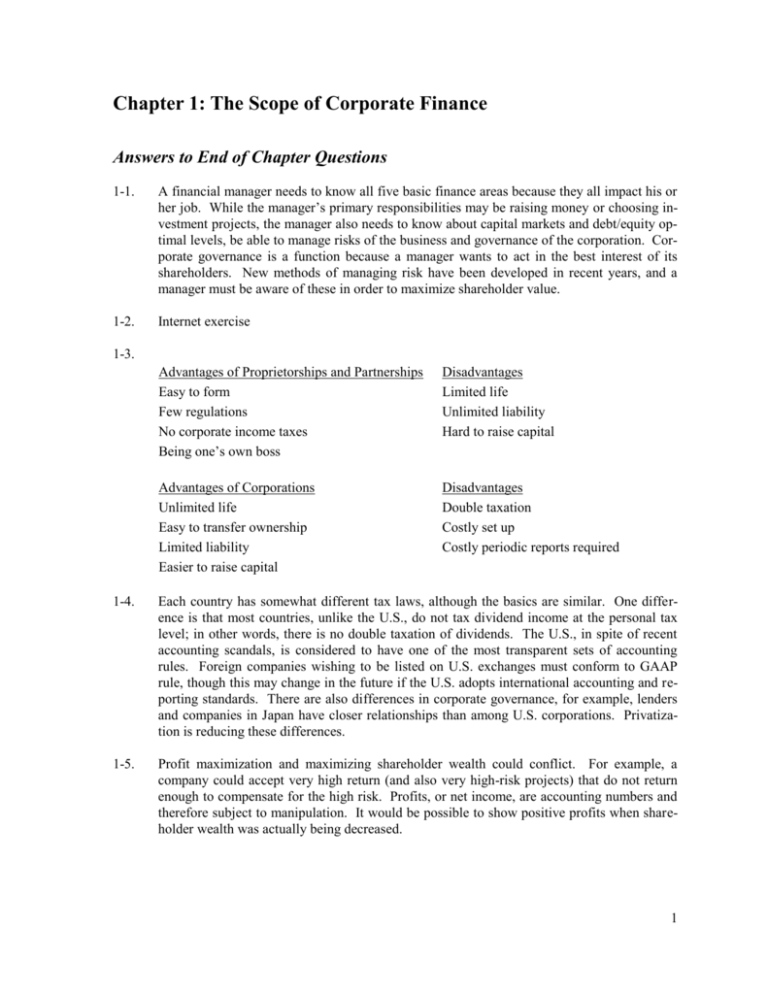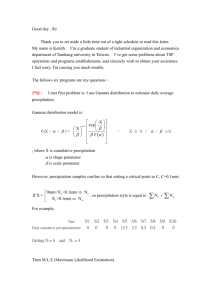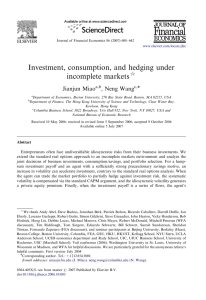Chapter 1 The Scope of Corporate Finance
advertisement

Chapter 1: The Scope of Corporate Finance Answers to End of Chapter Questions 1-1. A financial manager needs to know all five basic finance areas because they all impact his or her job. While the manager’s primary responsibilities may be raising money or choosing investment projects, the manager also needs to know about capital markets and debt/equity optimal levels, be able to manage risks of the business and governance of the corporation. Corporate governance is a function because a manager wants to act in the best interest of its shareholders. New methods of managing risk have been developed in recent years, and a manager must be aware of these in order to maximize shareholder value. 1-2. Internet exercise 1-3. Advantages of Proprietorships and Partnerships Easy to form Few regulations No corporate income taxes Being one’s own boss Disadvantages Limited life Unlimited liability Hard to raise capital Advantages of Corporations Unlimited life Easy to transfer ownership Limited liability Easier to raise capital Disadvantages Double taxation Costly set up Costly periodic reports required 1-4. Each country has somewhat different tax laws, although the basics are similar. One difference is that most countries, unlike the U.S., do not tax dividend income at the personal tax level; in other words, there is no double taxation of dividends. The U.S., in spite of recent accounting scandals, is considered to have one of the most transparent sets of accounting rules. Foreign companies wishing to be listed on U.S. exchanges must conform to GAAP rule, though this may change in the future if the U.S. adopts international accounting and reporting standards. There are also differences in corporate governance, for example, lenders and companies in Japan have closer relationships than among U.S. corporations. Privatization is reducing these differences. 1-5. Profit maximization and maximizing shareholder wealth could conflict. For example, a company could accept very high return (and also very high-risk projects) that do not return enough to compensate for the high risk. Profits, or net income, are accounting numbers and therefore subject to manipulation. It would be possible to show positive profits when shareholder wealth was actually being decreased. 1 2 Chapter 1 1-6. Stakeholders include anyone with an interest in the company, including stockholders. Stakeholders are also management, employees, the government, the community, suppliers, customers, and lenders. Stakeholder wealth preservation appears to favor socialism more than capitalism. Stakeholder wealth, for example, keeping on too many employees for the firm to be efficient, may be preserved at the expense of stockholder wealth. 1-7. Agency cost or agency conflict refers to any time a decision is made that does not maximize shareholder wealth. For example, managers may want excessive benefits, such as a fleet of company planes that maximize their person satisfaction, but conflict with maximizing shareholder wealth. These costs can be minimize by, for example, tying management’s compensation to stock price so they have an incentive to work to maximize stock price. Such contracts can be effective if structured properly, although they have been criticized as providing excessive gains to managers when the entire market was rising. 1-8. Ethics are critical to stockholder wealth maximization. Unethical behavior can have severe financial consequences to a company, for example, Arthur Anderson went bankrupt because of its role as a corporate accountant for Enron and its other clients because of the fallout from Enron’s collapse. For many businesses, reputation is critical to conducting business. A firm with a reputation for shady dealing will lose value relative to its ethical competitors. Solutions to End of Chapter Problems 1-1. If the firm is organized as a partnership, operating income will be taxed only once, so investors will receive $500,000 x (1-0.45) = $275,000. If the firm is organized as a corporation, operating income will be taxed once at the corporate level and again at the personal level, so investors will receive only $500,000 x (1-0.36)(1-0.45) = $176,000. The “corporate tax wedge” is thus $99,000, or 19.8 percentage points. Using the pre-1981 tax rates, partnership investors would receive a net $150,000 of operating income, while corporate stockholders would be able to keep only $75,000 of the $500,000 in operating income.* 1-2. Payoffs to Project #1 Probability 1/3 1/3 1/3 Expected Payoff * Gross Profit Manager’s Flat Pay Stockholders Payoff $ 0 3,000,000 9,000,000 $4,000,000 $300,000 300,000 300,000 $300,000 $ -300,000 2,700,000 8,700,000 $3,700,000 Manager’s Stockholders 10% Payoff Payoff $ 0 300,000 900,000 $400,000 $ 0 2,700,000 8,100,000 $3,600,000 Note that this solution assumes that the corporation is not re-investing any of its profits, but is distributing all of its profits to shareholders as dividends. The Scope of Corporate Finance 3 Payoff to Project #2 Probability 1/2 1/2 Expected Payoff Gross Profit Manager’s Flat Pay Stockholders Payoff $600,000 900,000 $750,000 $300,000 300,000 $300,000 $300,000 600,000 $450,000 Manager’s Stockholders 10% Payoff Payoff $60,000 90,000 $75,000 $540,000 810,000 $675,000 Project #1 has the higher expected gross profit ($4,000,000 vs. $750,000 for Project #2) and stockholder’s payoff ($3,600,000 vs. $675,000 for Project #2). If Project #1 is chosen, the manager would prefer the 10% payoff because it provides greater compensation ($400,000 vs. $300,000 flat compensation). Technically under a flat compensation arrangement the manager would be indifferent because his or her compensation would be a flat $300,000 in either case. Under a profit-sharing arrangement, the manager would prefer Project #1 because it would provide him or her with greater compensation ($400,000 vs. $75,000 for Project #2). The profit-sharing arrangement better aligns the interests of the shareholders and manager and provides maximum benefit to both stockholders ($3,600,000 vs. $675,000 for Project #2) and managers ($400,000 vs. $75,000 for Project #2).






